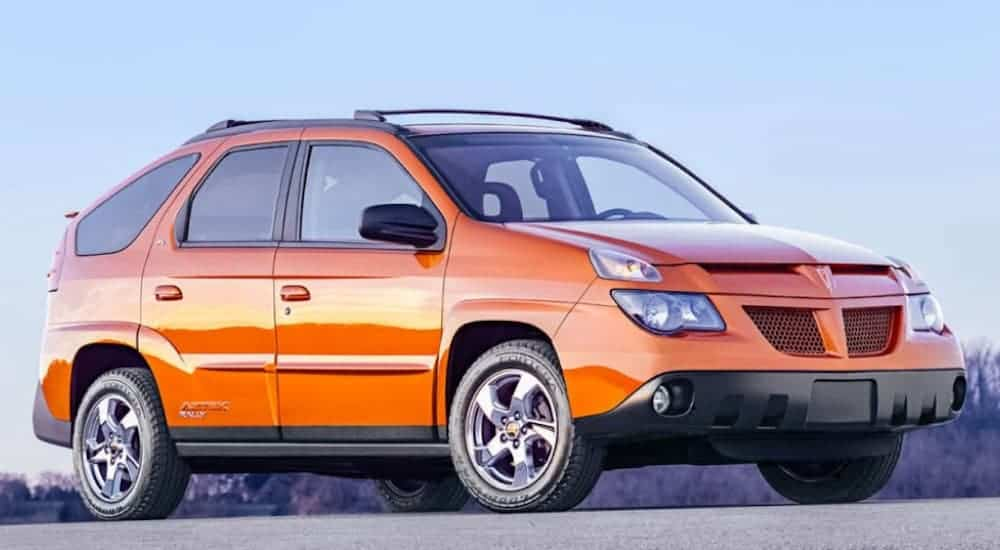Imagine you’ve been stranded on a remote island in the Indian Ocean for the past 39 days. In that time, you’ve been forced to eat bug larvae, compete in grueling challenges, and even listen to your fellow castaways play ukulele. Despite disturbing the rest of the group with your predilection for nudity, you manage to outwit, outplay, and outlast your fellow competitors and claim a cool million-dollar prize. You might finally be off the island, but one of your biggest challenges is still ahead of you: being seen around town in a Pontiac Aztek.
That was the plight of Richard Hatch, the Rhode Island native who would become a household name in late 2000 when he won the inaugural season of “Survivor.” The CBS smash-hit would launch 46 seasons of “Survivor”-branded content and usher in a new era of reality competition shows, but none could boast the same track record for product placement. As part of a partnership with General Motors, Probst & Co. initially rewarded contestants with the Pontiac Aztek, a short-lived midsize SUV that would never live up to the hype generated by its “Survivor” cameo.
In some ways, the Aztek was the perfect fit for “Survivor.” This crossover SUV—with its available all-wheel drive, camping-friendly interior, and “active lifestyle” ethos—meshed well with the show’s rugged, outdoorsy nature. Unfortunately, the Aztek was less appealing for those who hadn’t spent the last five weeks being eaten alive by bugs and subsisting on white rice, leading GM to discontinue the Aztek just five years into its first generation.
The Aztek would go down in history as one of the worst flops of its time, landing on both TIME’s “50 Worst Cars” and “50 Worst Inventions” lists. That might be a bit harsh, especially when you consider this SUV’s favorable early reviews—so what went wrong? Read on as we delve into Pontiac’s ill-fated attempt to cater to the finicky Gen-X market and see why no number of immunity idols could save the short-lived Aztek…
Innovation Above All Else
The Aztek was always intended to be something of a novelty. While sticking to an established formula is usually a safe play, GM execs were looking to shake things up as the company entered the new millennium.
A new generation of Japanese crossovers like the Toyota RAV4, Honda CR-V, and Subaru Outback were taking the US market by storm, leaving domestic automakers to play catchup on home soil. Ford rolled out the Escape crossover to complement its body-on-frame Expedition and Excursion, but GM’s Pontiac sub-brand was way behind the curve with a lineup totally devoid of SUVs.
This stagnation led GM CEO Rick Wagener to deliver one of the more infamous mandates in modern auto history: 40% of all new GM products now had to be “innovative.” This vague declaration led GM designers to roll out some highly experimental vehicles that, at most other companies, would have been one-off concept models at best.
“Everything that seemed radical got the green light,” said former GM executive Bob Lutz. Conceived as a hybrid of the Chevy Camaro and Blazer, the Aztek was certainly radical. This crossover SUV—sporting a 185-hp, 3.4-liter V6—was built specifically for the Gen-X market. Designed with (in Pontiac’s own words) “Xtreme” futuristic styling, the Aztek serves as a regrettable time capsule of the Y2K aesthetic.
To be fair, the Aztek was certainly lousy with innovations. Aimed at a young, active consumer base, this SUV packed a number of features intended to make it an all-in-one adventure vehicle. The Aztek was actually one of the first vehicles with a head-up display, but its most notable attribute would probably have to be that the Aztek could double as a camper with an included tent that stretched over the rear half of the vehicle.
The SUV’s unique tailgate design gave campers plenty of headroom, which—along with the built-in air compressor, 20-speaker Pioneer sound system with trunk-mounted control, and a 12-volt outlet—allowed for a sort of proto-glamping. GM rounded the Aztek out with a number of well-intentioned if poorly-thought-out features, including a seat-mounted backpack, removable rear cargo tray, and a center console that could be used as a portable cooler.
Despite these nifty creature features, the Aztek was never really geared for off-road success. While this crossover was offered with available all-wheel drive, front-wheel drive was the standard. Even worse, the Aztek only featured 7.2 inches of ground clearance, making it essentially useless for all but the mildest off-road excursions.
Then there was the price. With an MSRP of $20,000 ($36,000 in 2024 dollars), this SUV was simply too expensive for the twentysomething weekend warriors for whom it was designed. If the Aztek’s intended audience actually existed, they sure didn’t show up at their local Pontiac dealership.
The Tribe Has Spoken
There’s certainly nothing wrong with a little innovation, but Lutz paints the Aztek as a prime example of innovation for innovation’s sake. The former exec describes something of a pro-innovation echo chamber at GM HQ, which created a myopic atmosphere that stifled any dissenting opinions. “We all believed that Aztek would be the winner,” said Lutz. “‘It will surprise the world. I don’t want to hear any negative comments about this car. None. If somebody has a bad opinion about it, let them leave the team.'”
If a camel is a horse designed by a committee, then the Aztek was the humped desert dweller of the Pontiac lineup. While the Aztek was originally intended to feature a low, sporty design, GM execs preferred a higher, narrower shape. Instead of pushing back, GM designers simply pushed ahead, incorporating the changes and producing a crossover chimera that would come to confound the market as a whole.
Early market research groups panned the SUV’s design, but GM was not having any of it, forging ahead and introducing the Aztek at the Detroit Auto Show in 1999. The reaction was resoundingly negative, as summed up by automotive critic Dan Neil in TIME’s “50 Worst Cars of All Time” article: “This car could not have been more instantly hated if it had a swastika tattoo on its forehead.”
“The Aztek design had been fiddled with, fussed over, cost-shaved, and otherwise compromised until the tough, cool-looking concept had been reduced to a bulky, plastic-clad mess,” wrote Neil. “The Aztek violates one of the principal rules of car design: We like cars that look like us. With its multiple eyes and supernumerary nostrils, the Aztek looks deformed and scary, something that dogs bark at and cathedrals employ to ring bells.”
Neil laments these polarizing design choices, admitting that, “under all that ugliness, there was a useful, competent crossover.” JD Power echoed Neil’s sentiment, awarding the Aztek its “Most Appealing Entry Sport Utility Vehicle” award in 2001 as this SUV notched the highest Customer Satisfaction Index scores in its class. Still, even JD Power couldn’t ignore this crossover’s regrettable styling, noting that the Aztek scored highest or second highest in every APEAL component measure… except exterior styling.
The Aztek’s widely panned veneer is a bit surprising given the pedigree of its architect, famed GM designer Tom Peters. Peters would go on to give us the beloved seventh-generation Chevy Corvette, but the Aztek was definitely something of a learning experience. This SUV’s squared-off design, excessive plastic cladding, square front wheel wells, and stubby, pug-like snout certainly weren’t winning over many drivers, but it was TotalCarScore.com CEO Karl Brauer who delivered the most damning-if-hilarious assessment, likening the Aztek to “a station wagon stretched out by a car bomb.”
Ahead of Its Time?
GM had projected annual sales of around 75,000 for the Aztek, but in the end failed to top more than 27,000 in any given year. GM downsized the trim lineup in the Aztek’s second year, dropping the GT trim and drastically cutting prices, but it wouldn’t be enough to save this crossover camel. Pontiac discontinued the Aztek after 2005, retooling the factory to produce the Chevrolet HHR and replacing the Aztek with the more conventional but equally short-lived Pontiac Torrent, a midsize crossover that was available until 2009.
While this SUV was certainly never a commercial success, it certainly had an impact on pop culture. The Aztek’s star turn on “Survivor” would generate a little buzz for the show’s first two seasons, but the crossover would later be replaced by some equally ill-fated GM models like the Saturn Vue and Ion, Pontiac G6 and Torrent, and Mercury Mariner. This crossover was also featured on the Fox series “Dark Angel” from 2000 to 2002 but is probably best remembered for ferrying around Alberquere’s favorite outlaw chemist in “Breaking Bad.”
Walter White’s custom-painted gray-green Aztek is commonly cited as a masterful stroke of automotive casting, with this SUV reflecting the string of bad luck that landed White with a hum-drum existence as a high school science teacher. Fittingly, White trades in the Aztek for a flashier Chrysler 300 as he embraces his edgier Heisenberg persona—a subtle piece of set design that speaks to the show’s genius.
While it’s easy to write the Aztek off as a failed experiment, there’s also an argument that this SUV was simply ahead of its time. While it might approach an almost criminal level of hyperbole, one prominent critic likened the Aztek to the Apple Newton or Mac Portable, two early computing products that set the stage for later game-changing innovations from a modern-day tech giant.
Crossover SUVs have certainly become a dominant force in today’s auto market, especially when it comes to specialty trims aimed at outdoor enthusiasts. A new generation of “soft-roaders” continue to follow in the Aztek’s footsteps, offering rugged styling and moderate off-roading ability. Looking at the roof-mounted tents that have become popular in the SUV and pickup sectors, it’s easy to see the Aztek’s influence shining through.
In the end, the Aztek serves as a cautionary tale for any auto exec prone to ignoring focus groups and customer feedback. This SUV served to showcase some interesting concepts—especially in the potential for camping offered by the included tent, outlets, and air compressor—but the Aztek was never destined for widespread success. This can largely be credited to a fundamental misreading of the intended Generation X customer base, who weren’t quite as fond of gimmicks and polarizing style choices as some of GM’s stuffed shirts might have predicted.
Ultimately, it was probably the high starting price that probably sunk the Aztek. While one has to give Pontiac credit for jumping on the crossover trend early, the Aztek represents the segment’s awkward teenage years; auto execs hadn’t quite nailed the crossover formula, and the Aztek was the logical result of these growing pains. So, while the Aztek certainly has its eccentric fans today, the tribe has already spoken on Pontiac’s early crossover experiment.




